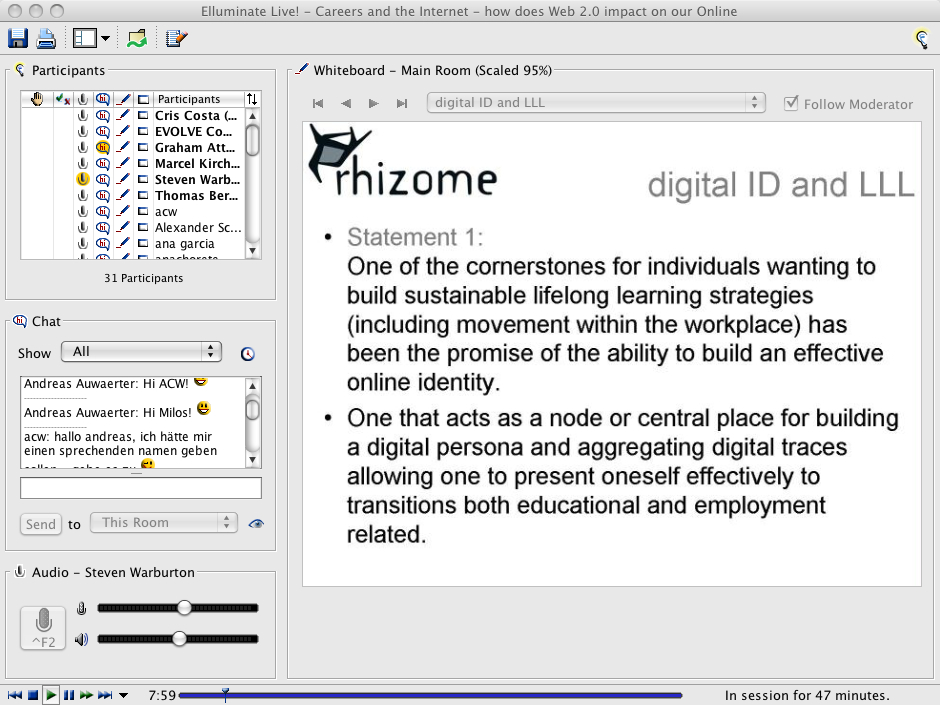I,m working on a new paper on PLEs. I’m finding the idea of Rhizomatic learning extremely useful. Here is an extract from the paper.
‘Technologies are changing fast and our use of technologies is changing faster. In looking to the future it may be worth returning ot the them of rhizomatic learning (Cormier, 2008). Dave Cormier says the rhizome is a botanical metaphor. “A rhizomatic plant has no center and no defined boundary; rather, it is made up of a number of semi-independent nodes, each of which is capable of growing and spreading on its own, bounded only by the limits of its habitat. In the rhizomatic view, knowledge can only be negotiated, and the contextual, collaborative learning experience shared by constructivist and connectivist pedagogies is a social as well as a personal knowledge-creation process with mutable goals and constantly negotiated premises.”
Such social processes in the use of technology for learning and knowledge creation have been seen in a conference and a summer school which I have recently attended. In both, we created a tweme for the event, a mash up of delicious, twitter and flickr based on a common tab. In neither case did we pre-announce the use of the tweme, neither was the use of the particular technology officially prescribed nor indeed endorsed by the event organizers. However the use of the tweme for knowledge sharing was adopted organically by participants and became the main means of ICT based communication and sharing. In one case the conference organizers had established their own NetVibes site for the mash up of blogs; however by the second day they recognized what was happening and emailed participants to inform them that the tweme was “ the main channel for information” going on to say “Please have a look on it because the freshest and the hottest information can be found only from there.”
One interesting effect of the use of twitter and twemes was to facilitate the unplanned participation of researchers and practitioners from all over the world in the vents and a consequent wider and open dialogue than the original programme and curriculum design had envisaged. The curriculum was being increasingly developed by the community and the community extended to include participants who were not present face to face.
The technological development facilitating such change was the availability of connectivity and the use of different devices. In fact at the first conference connectivity was problematic. The wireless network became overloaded. Nevertheless, participants found ways of communicating, using other mobile phones or a skype to twitter interface which required less bandwidth than a browser. Those with access to neither simply recorded their observations and rushed off to find better bandwidth in the coffee break.
The agenda and curricula of the vents became extended through participants negotiating topics they wished to explore through the ongoing discourse and organising ‘unconferencing’ events outside the main programme.
Such experiences may point the way to how personal learning environments will evolve in the future. The PLE will not be one application running on the desktop or in a web browser. Rather, it will be multiple applications running on may different devices. It is also important to understand that learners will use different devices in different contexts and for different purposes. The PLE will be based on networks of people with whom learners interact, they may adapt a particular tool for communication and interaction in a particular context but then cease to sue that tool when that context has passed. In previous projects linked to mobile learning we have tended to focus on how to transmit standardised learning materials and applications to different platforms and devices.
The PLE will be comprised of not only all the software tools, applications and services we use for learning but the different devices we use to communicate and share knowledge.
This if knowledge seen as resting in connections and learning bases on those connections then PLE may be sum of devices plus use of those devices for learning. Another way to view the PLE is to see it as the summation of connections we make in a nodal learning network. This includes, of course, face-to-face interactions both in terms of participation in learning programmes and events but also one to one and informal interactions and an ongoing process of reflection and sense making of such interactions. Learning and learning environments become synonymous with the identity of the leaner, both the self perceived identity and the learner as others perceive them.

 I am greatly intrigued by Martin Weller’s presentation on SocialLearn yesterday. One of the advantages of Elluminate is it allows you to watch a
I am greatly intrigued by Martin Weller’s presentation on SocialLearn yesterday. One of the advantages of Elluminate is it allows you to watch a